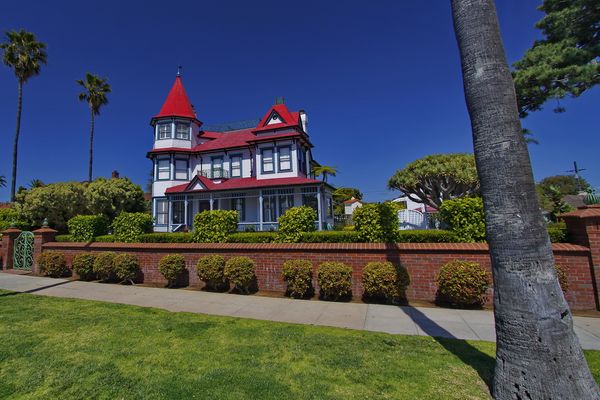Circular Polarizer
Apr 5, 2012 22:03:26 #
jvangorp
Loc: Stickney, SD
I recently purchased a B + W circular polarizer for a trip we will be taking soon to some sunny destinatios. I have taken a few shots with it, and they are of course darker. Any hints on using my new filter?
Apr 5, 2012 22:12:07 #
jvangorp wrote:
I recently purchased a B + W circular polarizer for a trip we will be taking soon to some sunny destinatios. I have taken a few shots with it, and they are of course darker. Any hints on using my new filter?
It would be nice if they had "clicks" on them. So when you
turn it you can have 1 click, 2 clicks and so on.
I just turn mind to what looks good and see what I get later.
So I guess I could use a good answer
Apr 5, 2012 23:17:55 #
jvangorp wrote:
I recently purchased a B + W circular polarizer for a trip we will be taking soon to some sunny destinatios. I have taken a few shots with it, and they are of course darker. Any hints on using my new filter?
You really have to look through the viewfinder and turn the filter until you get the affect you are looking for. There is no right or wrong way. Pay attention to water and sky. To remove glare, watch the water surface as you turn... When the glare disappears, then you are ready to shoot. Likewise with the sky---when the sky turns dark blue, you'll know it.
Also, keep in mind that polarizing filters work best when the sun is at a 90 degree angle from the horizontal plane of your lens. Therefore, if you are looking for the deep blue sky, then you'll want to take shots between 11am and 1pm.
A final tip. It's very hard to see the affects through the viewfinder when you are wearing sun glasses (most have polarizing lenses as well). Of course, during high noon, sun is when you'll want to be wearing them. I usually have to take my sun glasses off to compose a shot. Very annoying.
Here's a shot I took with mine slightly before noon.
Corodano Real Estate

Apr 6, 2012 00:13:34 #
jvangorp wrote:
I recently purchased a B + W circular polarizer for a trip we will be taking soon to some sunny destinatios. I have taken a few shots with it, and they are of course darker. Any hints on using my new filter?
Best tips are to practice with it HEAVILY so you instinctively know when it will improve a scene, and when it won't! Know your filter as well or better than you know the lens you will use it on. And don't be afraid to try it on scenes you may not at first think it appropriate for, it can really bring out color saturation in the right situations. The biggest mistake most photographers make is OVER-using the CP. Use it judiciously, but LEARN and enjoy the effects it can give, you have a very good CP there.
Apr 6, 2012 02:01:01 #
mdorn wrote:
You really have to look through the viewfinder and turn the filter until you get the affect you are looking for. There is no right or wrong way. Pay attention to water and sky. To remove glare, watch the water surface as you turn... When the glare disappears, then you are ready to shoot. Likewise with the sky---when the sky turns dark blue, you'll know it.
OK, Im going to reveal my boundless ignorance here. But why would one want or need to rotate the CP filter? Isnt the effect the same throughout the filter? Not like a grad ND? I recently bought my first CPF, and know I must be missing something, because Ive been puzzled by the fact that the filter never stops when I turn it, i.e. like a screw that never goes all the way in. I guess I never paid attention to the fact the effects change as you turn it? I will play with this tomorrow. Have been enjoying it though, despite my ignorance. Love the way it brings out texture in clouds.
Apr 6, 2012 02:50:22 #
A CP filter will not work properly unless you rotate the ring/lense to the correct angle of the light waves. Also it does step down the lighting at least -1 so you either adjust you camera or adjust the photo in your editing program.
This shot was off the dock in bright sun in the Caribean. note no glare and the feet look like they are just hanging there.
Harvey
This shot was off the dock in bright sun in the Caribean. note no glare and the feet look like they are just hanging there.
Harvey
globetrekker wrote:
quote=mdorn You really have to look through the v... (show quote)

Apr 6, 2012 05:24:18 #
Harvey wrote:
Also it does step down the lighting at least -1 so you either adjust you camera or adjust the photo in your editing program.
With through the lens metering there will be no need to make any adjustments because of using a filter -- the camera will make the adjustments automatically unless you are shooting in manual and NOT using the built in light meter.
Apr 6, 2012 07:15:34 #
If you like to see the effects of your filter aim it at your TV with the TV on... and turn the ring....check it out...you will see the difference....:)
jvangorp wrote:
I recently purchased a B + W circular polarizer for a trip we will be taking soon to some sunny destinatios. I have taken a few shots with it, and they are of course darker. Any hints on using my new filter?
Apr 6, 2012 08:39:39 #
I think the best way to become familiar with the changes and results that a polarizer provides is to simply put the camera down put the polarizer between your thumb and forefinger and start going around and giving a spin in your fingers so you can see the effects without worrying about composition. I use a handful of CPF's and would never be without them. You will be amazed once you realize just how they work. Sit in your well lit house and give it a spin and you will see reflections on windows, and glares off tables and such simply disappear and the saturated color pop out.
Apr 6, 2012 09:32:38 #
[quote=globetrekker]
Read this article, maybe it will help you understand the polarization process a little better.
http://camerapedia.wikia.com/wiki/Polarizer
mdorn wrote:
br OK, Im going to reveal my boundless ignorance... (show quote)
Read this article, maybe it will help you understand the polarization process a little better.
http://camerapedia.wikia.com/wiki/Polarizer
Apr 6, 2012 11:23:16 #
globetrekker wrote:
OK, Im going to reveal my boundless ignorance her... (show quote)
Why would you buy/use a CPF if you aren't sure how it is used or what the benefits are? This reminds me of the JPG vs. RAW debate. People shoot RAW because they think they have to to become a "serious" photographer, not because they are trying to solve a specific problem or create a desired affect.
I realize everyone has to start somewhere, and it looks like you are having fun experimenting with yours, but I guess this is just not my preference. I like to research and mull over things way too long before I open my wallet. Regardless, I'm glad you are finding out now.
Apr 6, 2012 11:50:35 #
mdorn wrote:
Why would you buy/use a CPF if you aren't sure how it is used or what the benefits are? This reminds me of the JPG vs. RAW debate. People shoot RAW because they think they have to to become a "serious" photographer, not because they are trying to solve a specific problem or create a desired affect.
Did know the benefits. But apparently not how to use. Yet even not knowing about turning the CPF, I have still seen benefits. Will only get better now.
Apr 6, 2012 11:58:28 #
Apr 6, 2012 13:02:14 #
globetrekker wrote:
Did know the benefits. But apparently not how to use. Yet even not knowing about turning the CPF, I have still seen benefits. Will only get better now.
mdorn wrote:
Why would you buy/use a CPF if you aren't sure how it is used or what the benefits are? This reminds me of the JPG vs. RAW debate. People shoot RAW because they think they have to to become a "serious" photographer, not because they are trying to solve a specific problem or create a desired affect.
Did know the benefits. But apparently not how to use. Yet even not knowing about turning the CPF, I have still seen benefits. Will only get better now.
Globetrekker,
A little more descriptive discussion may be needed to understand how the CPF performs its task and how to make the best use of this filter.
The CPF contains two parts; part 1 screws into the objective element of your lens (Cokin CPF slides into a filter holder).
Part 2 is attached to part 1 and rotates about a central axis to your lens. (The Cokin CPF has one part and rotates within the filter holder).
Light comes from many different sources, the one source we are most interested in is daylight. Daylight normally comes from our Sun and is considered a point light source. Stars at night are a point light source and the Sun is a star. The Moon and Planets are reflected light sources, light from a point light source is reflected off the surface of a planet, or moon.
When light from the Sun passes through our sky some of the photons strike molecules within the air and are deflected at a slightly different angle than the point light source. When these photons strike a reflective surface (water, glass, moisture in the upper air) they reach our eye, and the camera, at a different angle than the direct sun light.
Rotating the CPF element allows the filter to block most of the reflected light sources there by reducing the glare effect from the sky, water, and glass. Rotating the CPF element allows you to control how much reflected light to block, it introduces creativity into your captured image. (Example: You are at a store front with a large picture window and you ant to capture the display inside the window. You compose the image the way you need it, but you notice all the street activity behind you reflected in the glass window, this seriously detracts from the image you need to capture. Using a CPF you can rotate the CPF to remove the reflected light, or reduce the reflected to a point where it is not a distraction, but a minor enhancement to the overall image.)
Rotating the CPF element on a landscape image allows you to control how much of the sky is affected. In most cases the sky may have 45 degrees affected by a darkening of the sky, but by rotating the CPF element you can balance the effect across the field of view, or adjust the CPF for the desired effect within the camera.
The more correction in camera you can obtain the less time you will spend in the digital darkroom.
Michael G
Apr 6, 2012 16:10:54 #
agreed that a polarizer is probably the most misused filter in use; if improperly used, it will create a dark image and do nothing to enhance the image quality.
If you want to reply, then register here. Registration is free and your account is created instantly, so you can post right away.








